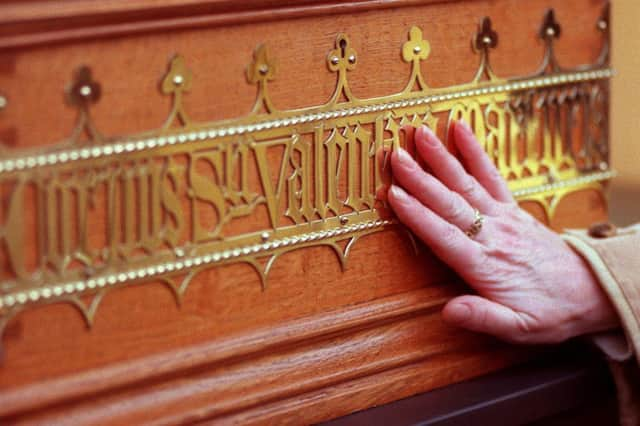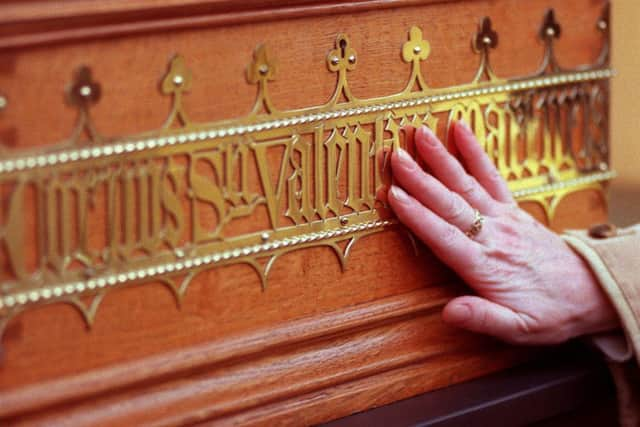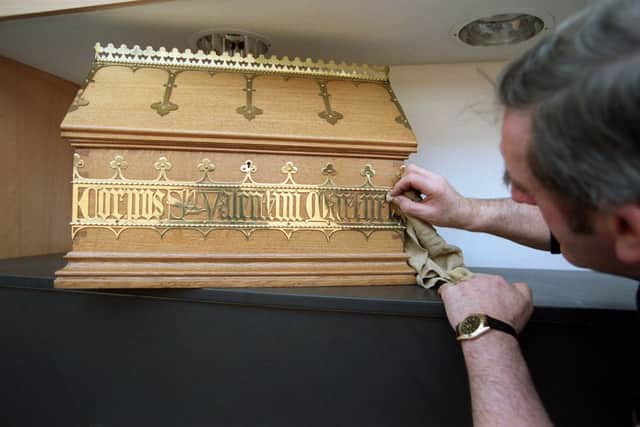St Valentine’s remains and Glasgow, city of love


Transit vans, HGVs and hurried commuters drive by it every day without giving it much thought. It makes little impression on pedestrians who walk past its dark, spittle-beaten brown brick walls. On a clear day, and with your head up, some modestly decorated figures in prayer - some are painted white, others wear a coat of pale peach or sapphire blue - can be seen in the corner of the church courtyard. Above a white delivery van parked nearby, a familiar figure is pinned to a crucifix. His claret-stained feet are at head-height.
The Ballater Street friary is neither grand nor imposing, but within its walls is something no other place of worship in Scotland has - something responsible for Glasgow’s informal title as the City of Love. Beyond the church entrance on the left hand side of the light, wood-panelled interior is an ornate 3ft-wide chest - known as a reliquary - gilded with the words ‘Corpus Valentini Martyris’. Inside, shielded from the public by a thick glass pane, are some of the remains of one St Valentine. In the week leading up to February 14th, a statuette of the saint is placed beside the relic and decorated with red roses. Men have been known to propose to their girlfriends on St Valentine’s Day next to the reliquary. Special services are held to acknowledge those in love; prayers are also said for those still seeking it. Blessed John Duns Scotus becomes “hectic” on the 14th.
Advertisement
Hide Ad“They have done so, yes,” says Rev Edmund Highton of the impromptu marriage proposals at the church, “I’ve seen it happen while I’ve been here. They just come in, and you see one of them get down on the knee, and so on.”


The values that St Valentine ostensibly stands for - romance, companionship, true love - are held in high esteem by the church; the saint himself is another matter. Ask most people on the street what they know about St Valentine, and they’ll likely reel off a list of gifts they’ve given or received in mid-February; they’ll maybe shrug when pressed further. Father Edmund’s shrug is quite audible when I ask him about St Valentine.
“It’s not an important one for me. That’s just a matter of history. We’ve got these relics, people come in, and they have a devotion. They see it as a focus for themselves, that’s all. St Valentine was a martyr saint who gave witness to his faith, that’s all I’m interested in. That’s good.”
Blessed St Johns Scotus, according to Rev Antony Collins, has the forearm of St Valentine. The rest of him is housed across Europe: in Rome, the skull of St Valentine is on display in the Basilica of Santa Maria. Other remains can be found at Whitefriars Street Carmelite Church in Dublin, Ireland and at the Birmingham Oratory. France, Malta and the Czech Republic reportedly own reliquaries of St Valentine as well.
Remains spread throughout the world


This diffusion of reliquaries - a ‘spreading of the love’, if you will - is the combined result of historic gift-giving between church officials and periodic exhumation of St Valentine. The business of identifying the saint is a tricky one, made all the more complicated by the fact that he may be at least two different people. On the one hand, records say he was a third century Bishop of Terni imprisoned, tortured and beheaded at Via Flaminia near Rome on the orders of a Roman prefect, Placid Furius; a later, more popular hagiography has it that Valentine of Rome, a priest or bishop in the city, was also martyred by Emperor Claudius the Goth at Via Flaminia (some scholars argue that these two accounts are overlapping fragments of the same story). According to the Nuremberg Chronicle (a late 15th century tome which took the bible and the oral tradition as inspiration rather than historical fact) the latter Valentine restored the sight of his jailer’s daughter while imprisoned for giving aid to Christians. Later versions of the story attempt to link Valentine with acts of passion or romance, but the truth of these accounts is questionable at best.
A pagan festival pre-dating Christianity called Lupercalia, celebrated over three days in mid-February (and during what is now Valentine’s Day), has a far more explicit connection with the early romantic tropes of Valentine’s Day. The ritual required two young men to skin a goat and a dog, and make whips out of the hide to strike the bottoms of girls in order to make them fertile. Lupercalia was later appropriated by Pope Gelasius in AD 494 when he declared February 14 to be a Christian feast day. David Jasper, a literature and theology professor at Glasgow University, says this may go some way to explaining how Valentine’s Day came about.
Advertisement
Hide AdHe says the celebration of Valentine’s Day was “purely pagan. The connection with the Christian Valentine was completely false.”
“In the Dictionary of Christianity, it doesn’t even mention St Valentine at all. The commemorations of the two Valentines was always February 14, and what tends to happen is you get the confusion where if you get a pagan festival at around the same time as a Christian festival then the two become conflated with one another - they don’t have to have anything to do with one another. The two Valentines, who were martyrs, and that wasn’t unusual in the third century, I think it just happened. It was happenstance that their festival was February 14.”
Advertisement
Hide Ad

The ultimate responsibility for the Valentine’s Day now celebrated with a deluge of flowers, cards and chocolates between the sexes falls on English author Geoffrey Chaucer. Sometime around 1382, Chaucer wrote Parliament of Foules. The poem was the first piece of literature to connect St Valentine with romantic love, and from there the idea took hold, however slowly, to the extent that William Shakespeare referenced St Valentine’s Day in Ophelia a little over 200 years later. By the 18th century, love notes written on paper and lace became popular in England, and a cheap means of mass production was thought up - Esther Howland of Worcester, Massachusetts began producing cards in 1847. The rest, as some might say, is a very commercialised history.
The reliquary containing the forearm of St Valentine arrived in Glasgow via a donation from a wealthy French Catholic family in 1868. It was kept in St Francis’ Church for over a century before being transferred to its current home in 1993. Though the remains are given a prominent position at the front of the church, it’s also easy to walk right straight past them. St Valentine’s Day, after all, only happens once a year.
“For most of us, he’s one of the saints like any other,” says Father Antony. “It’s based on the faith of the people. Some people come around this time of year [but] we don’t advertise it, really.”
The church’s reluctance to promote St Valentine, perhaps, stems from the fact that no-one really knows anything about him with great certainty. In 1969, the Roman Catholic Church removed St Valentine from the General Calendar, a liturgical calendar indicating the dates of saints to be celebrated. St Valentine is destined to remain a mystery.
“I feel sometimes that, even with Jesus Christ, you get descriptions and what have you, but you don’t get the photographic evidence required today”, laments Father Antony, “and what happens? Not so long ago the Shroud of Turin somehow appears. You might say that all the information that people would want today was there the whole time.
“It’s one of those puzzles - but life is a puzzle, isn’t it?”
SEE ALSO: